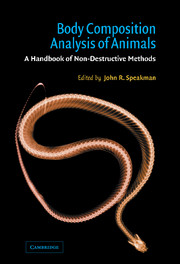Book contents
- Frontmatter
- Contents
- List of contributors
- Preface
- Acknowledgements
- Introduction
- 1 Morphological indicators of body condition: useful or wishful thinking?
- 2 Standard methods for destructive body composition analysis
- 3 The isotope dilution method for the evaluation of body composition
- 4 Gas dilution methods: elimination and absorption of lipid-soluble gases
- 5 The use of total body electrical conductivity (TOBEC) to determine body composition in vertebrates
- 6 The use of bioelectrical impedance analysis (BIA) for estimation of body composition
- 7 The assessment of body composition and other parameters by ultrasound scanning
- 8 The use of dual-energy X-ray absorptiometry for the measurement of body composition
- Index
Introduction
Published online by Cambridge University Press: 19 January 2010
- Frontmatter
- Contents
- List of contributors
- Preface
- Acknowledgements
- Introduction
- 1 Morphological indicators of body condition: useful or wishful thinking?
- 2 Standard methods for destructive body composition analysis
- 3 The isotope dilution method for the evaluation of body composition
- 4 Gas dilution methods: elimination and absorption of lipid-soluble gases
- 5 The use of total body electrical conductivity (TOBEC) to determine body composition in vertebrates
- 6 The use of bioelectrical impedance analysis (BIA) for estimation of body composition
- 7 The assessment of body composition and other parameters by ultrasound scanning
- 8 The use of dual-energy X-ray absorptiometry for the measurement of body composition
- Index
Summary
Interest in the body condition of animals in the wild has long been an important aspect of animal ecology. Perhaps because there is an intuitive feeling that understanding something about the status of an animal – in terms of its body ‘condition’ – might provide a suitable window through which we can start to perceive components of an animal's fitness. The underlying premise behind this belief appears to be that an animal that is in ‘good’ condition is more likely to be a fitter member of the population than an animal that is in ‘poor’ condition. This notion may derive from the impression that the individual in ‘good’ condition has had the ability to not only satisfy all its requirements but also to take good care of itself. In addition, the animal may also have had time to deposit a healthy fat store that would see it through times of food scarcity. In contrast, the poor animal may be suffering from the ravages of a disease or simply be incapable of securing a living at the same time as managing to maintain itself. Intuitively therefore, by quantifying body condition, we may also be quantifying in a single measure these diverse factors that comprise our understanding of the term ‘fitness’. Moreover, measuring the body conditions of the animals that live in a given area may not only tell us something about the animals but can perhaps also inform us about the area itself: its productivity, and the extent to which it can supply resources to sustain the population of animals that are living there.
- Type
- Chapter
- Information
- Body Composition Analysis of AnimalsA Handbook of Non-Destructive Methods, pp. 1 - 7Publisher: Cambridge University PressPrint publication year: 2001
- 10
- Cited by



